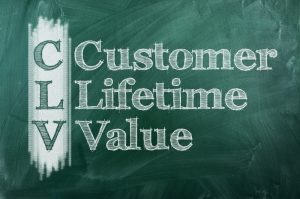The following is a guest post from Renee Wong, Partner at The CEO’s Right Hand, Inc.
What is a customer worth?
The answer to that question is a powerful piece of knowledge and is the reason that customer lifetime value (CLV), also known as Lifetime Value (LTV), is a crucial metric for businesses. Here we will explore some of the core aspects of CLV and ways to calculate and improve it.
What does this metric tell you?
CLV is essentially the dollar value of a customer relationship. It’s also described as a predicted value of what a business can derive from its entire relationship with a customer.
Knowing the CLV for each customer can help a business make optimal decisions. For instance, as some customers might be worth more than others, it would be beneficial for the business to be able to identify the most profitable customers. Further, an understanding of CLV across clients can help a company focus on maximizing value—rather than necessarily minimizing costs—in its plans for sales and marketing spending, as well as its customer service and acquisition costs.
CLV can be applied against customer acquisition cost (CAC) to measure the return on sales and marketing investments. The CLV:CAC ratio indicates the health of the business model and can help managers to see more clearly what is driving the business and to optimize the ratio.
The No-BS Financial Playbook for Small Business CEOs
Are you tired of making costly financial mistakes? Stop guessing and start growing. Learn how to create a scalable and valuable company while minimizing risk with this playbook from a serial entrepreneur who has been in your shoes.
In sum, understanding CLV can help companies increase customer retention, revenues and profitability, and therefore, CLV should be a critical part of a company’s business model and customer retention strategy.
How to Calculate CLV
There are two major ways to calculate CLV: historic CLV and traditional CLV.
Historic CLV
This is the simpler of the two methods and is based on what a customer has spent with the business in the past over a specific time period.
CLV = (annual revenue per customer x customer relationship in years) – customer acquisition cost
Example: Let’s say Company A generates $6,000 a year per customer, with an average customer lifetime of 8 years and a CAC of $8,000 for each customer. CLV = ($6,000 x8) – $8,000 = $40,000
The benefit to the historic CLV method is that it’s very simple. The downside is that it does not take into account changes in customer behavior and lumps all types of customers into one overall number.
Traditional CLV
This is a more in-depth and complex calculation and takes behavioral indications into account in addition to historical data. This aims to arrive at a total value that a customer will provide to your business over an entire relationship.
The formula is as follows: CLV = GM x (R / [1 + D – R])
Where
GM = average gross margin per customer lifespan
R = retention rate
D = discount rate
Example: Let’s say Company B delivers a meal-preparation subscription service (e.g. Blue Apron) for $240 a month and has a margin of 75%. Assume a typical customer lifetime is 2 years. The gross margin (GM) = $240 x24 x75% = $4,320.
Let’s also say that the Company has a customer retention rate of 80% and that the discount rate is 4%. This would result in the following for Customer Lifetime Value:
CLV = $4,320 x (80% / [1 + 4% – 80%]) = $14,400
We can get more comprehensive by including more data points involved in acquiring a customer and/or introducing predictive modeling methods, but these two approaches provide a good approximation.
How to improve CLV
A business can improve its CLV through various means. A few methods include a) creating a loyalty program to provide incentives for repeat purchases, b) engaging in focused targeting of the most valuable customers, and c) improving overall customer relationships.
No two customers are equal. Managers need to identify the various customer segments and the corresponding value derived from each. By performing CLV analyses on a regular basis and by utilizing the data to prioritize business strategies and customer management, businesses can maximize their return on investment.



